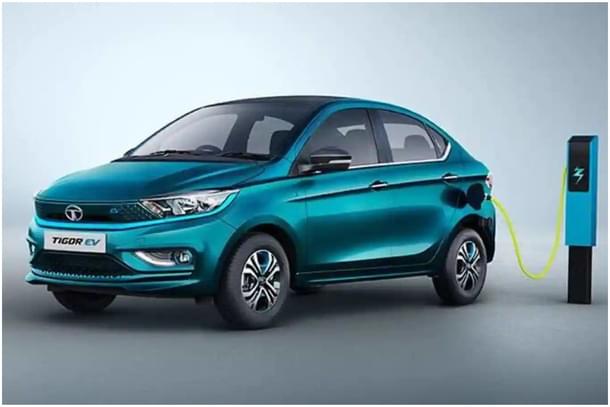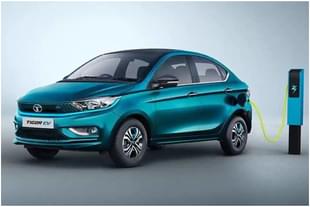Technology
Why Tata’s New Tigor EV Can Be A Game-Changer
Swarajya Staff
Aug 24, 2021, 10:56 AM | Updated 10:56 AM IST
Save & read from anywhere!
Bookmark stories for easy access on any device or the Swarajya app.


The Electric Vehicle car segment is a fledgling sector in the automotive industry in India. In fact, the only relatively successful product in the market is Tata’s Nexon EV which is a compact SUV and whose Internal Combustion Engine (ICE) counterpart has slowly and steadily risen to become one of the best selling cars in the mid-size SUV category.
The fact that a compact SUV and not a hatchback is the best selling EV car in the country, where hatchbacks have ruled the roost until now, speaks volumes as much about the lack of good options available in the market as it does about Tata Nexon EV’s capabilities.
This EV’s sales constitute 70 per cent of total market share!
The factors that work in its favour are design, five-star safety rating, affordable price (compared to the competition) and range (on paper — 312 km in single charge; 200-250 km in real life depending on various factors which influence an EV’s range).
However, the volumes continue to be disappointing. With over 5,500 units sold since January 2020, Nexon EV may be the best in India, but obviously there are some issues it has to overcome to appeal to the masses.
For instance, the range and price both are a hindrance for it to emerge as a true alternative to ICE cars, especially at the price point at which it is retailing.
If it is going to cost Rs 13-16 lakh to own an EV, people would at least want the car to go longer distances without stopping for a charge. If it's going to run 200-250 km at the maximum, then the price needs to be at par with Nexon’s ICE version (Rs 8-13 lakh).
If neither, at least there has to be a hybrid option, where the vehicle can run on petrol/diesel, if it runs out of charge.
It appears that Tata understands these existing challenges well and is the only company that seems interested in genuinely bringing in quality-but- affordable EVs for Indian consumers.
Last week, it unveiled the new Tigor EV, which is a huge improvement on its earlier versions, thanks to the Ziptron EV technology, which was hitherto available only in Nexon EV.
“Built on 5 strong pillars of Performance, Technology, Reliability, Charging and Comfort, the Ziptron technology has enabled Tata Motors to dispel, to a large degree, the popular myths surrounding the EVs today with respect to power, monsoon usage, reliability, suitability for long distance driving, frequency of charging and so on,” Anand Kulkarni of Tata Motors announced during the unveiling.
Tata had launched Ziptron in 2019 claiming it to have been designed and built-in house with ‘state-of-the-art’ powertrain EV technology comprising of ‘a highly efficient permanent magnet AC motor providing superior performance on demand. It also offers best-in-industry dust and water proof battery system meeting IP67 standards. Further, ZIPTRON utilizes smart regenerative braking to charge the battery while on the drive.’
It’s due to the Ziptron tech that Tata has been able to fit a much bigger battery pack (26kWh compared to 21.5 kWh in earlier version released earlier this year), which will deliver a considerably longer range (an estimated 350 km on paper compared to 213 km before).
Not only this, the battery will charge faster and the cost of the car is also expected to be same as before (around Rs 10 lakh at least for the base variant).
Even if the price is slightly higher, the available subsidies are going to make this the most affordable EV in India. As per the Centre’s FAME-ll subsidy scheme, both Nexon and Tigor EVs are eligible for Rs 1.5 lakh subsidy (Rs 10,000 per kWh up to 15kWh battery pack capacity).
In States like Delhi, there is an additional subsidy of Rs 1.5 lakh similar to the Centre’s, in addition to there being no road tax or registration charges on these vehicles — all combined together amounting to Rs 4.5 lakh worth of subsidy.
So, even if Tata prices the top-end of Tigor EV at Rs 11-13 lakh, then the on-road price for consumers (say, in Delhi) will be in the Rs 8-10 lakh range.
Tigor is a sedan and for some reason, its ICE version hasn’t appealed to consumers much. Maybe, it’s the design or dimensions or price; the point is it may not appeal to consumers who buy a car for prestige purposes.
However, the economics of usage may force them to rethink.
Nonetheless, as this Swarajya article argued, given such high subsidies on EVs, these could be a costly affair for the governments, which could end up losing lakhs of crores of rupees every year, especially if the EV revolution takes off.
Hence, the governments may have to soon decide on who to prioritise in subsidising. The obvious choice here is to go for light commercial vehicles, including passenger vehicles, which are owned privately, but are in taxi service (the yellow number plate people).
Five years ago, cars that went into taxi service were around 9 per cent of total passenger vehicle sales and were expected to reach 15-17 per cent by now.
This section of vehicles would be the right one to target for the government to get the best bang for its buck.
Here is what the (estimated) economics of Tigor EV could be: Assuming Rs 8 lakh out-of-pocket expense for the purchase after subsidy of Rs 3 lakh (plus road tax exemption) and given the fact that Tata gives a guarantee of 1,60,000 km on battery pack, if a Tigor EV cab drives 220 km per day for two years, then the total savings on fuel (taking Rs 100 petrol price and 20 kmpl as fuel efficiency) would be Rs 8 lakhs — equivalent of the original car price.
Assuming that the battery pack needs to be replaced after this, it is estimated that per kWh cost would come down to $100 by 2023.
This means that, car battery pack replacement would cost less than Rs 2 lakh. Still, a net savings of Rs 6 lakhs.
This may not be a huge amount for the upper or middle classes, but can be a game changer for the commercial industry and can effectively recover the cost of the vehicle for the driver.
With fuel costs gone, even EMIs won’t pinch and the drivers' disposable incomes will go up substantially.
Of course, the governments can further ease the pain and provide interest rate relaxations for those taxi owners who go in for EVs. An EV that goes 500 km and costs Rs 10 lakh has been long touted as a game-changer for a country like India.
While that may be some years away, an EV that goes 250-300 km in city conditions and costs Rs 10 lakh can prove to be a tipping point for the commercial cab industry.
That’s why Tigor EV can be a game-changer.





